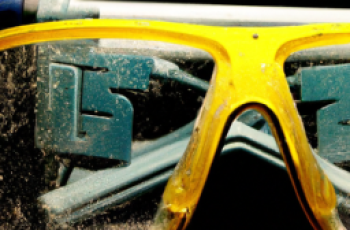In this article, you will discover essential safety protocols for bench grinders that will help protect your well-being and ensure a secure working environment. By following these guidelines, you can confidently utilize a bench grinder, knowing that you are minimizing potential risks and prioritizing your safety above all else. Whether you are a beginner or an experienced user, these safety protocols will provide you with valuable insights and practical tips for operating a bench grinder with confidence and peace of mind.
1. Personal Protective Equipment (PPE)
When working with bench grinders, it is crucial to prioritize your safety by wearing the appropriate Personal Protective Equipment (PPE). This equipment is designed to protect you from any potential hazards that may arise during the grinding process.
1.1 Eye Protection
Your eyes are extremely sensitive and susceptible to injury from flying debris, sparks, and particles generated by the bench grinder. Therefore, it is essential to wear proper eye protection, such as safety glasses or goggles, that are specifically designed for this type of work. Ensure that the eyewear you choose provides a snug fit and covers your eyes fully to prevent any potential hazards from reaching them.
1.2 Hand Protection
As you operate the bench grinder, it is vital to protect your hands from potential hazards such as cuts or abrasions. To achieve this, it is recommended to wear heavy-duty gloves that are resistant to sharp objects and sparks. These gloves will provide a barrier between your hands and any potential harm that may occur during the grinding process.
1.3 Hearing Protection
Bench grinders can generate a significant amount of noise, which may lead to long-term hearing damage if proper precautions are not taken. To protect your ears from the loud grinding noise, it is crucial to wear appropriate hearing protection, such as earplugs or earmuffs. These will help reduce the noise levels and safeguard your hearing health.
1.4 Respiratory Protection
During the grinding process, airborne particles and dust can be released into the air, posing a risk to your respiratory system. Protecting your lungs and airways by wearing an appropriate respiratory protection device, such as a dust mask or a respirator, is essential. Make sure to select a device that provides adequate filtration and fits comfortably to ensure optimal protection from harmful particles.
2. Machine Inspection
Before commencing any work with the bench grinder, it is crucial to conduct a thorough inspection of the machine. This inspection should take place both before use and during operation to ensure that the grinder is in proper working condition and free from any potential issues.
2.1 Pre-Use Inspection
Before turning on the bench grinder, carefully inspect the machine for any visible signs of damage, such as loose parts, frayed wires, or cracked grinding wheels. Ensure that all safety features, including guards and shields, are intact and functioning correctly. Check that the power switch and emergency stop button are easily accessible and working.
2.2 Inspection during Operation
While operating the bench grinder, remain vigilant and conduct regular inspections to identify any potential issues that may arise during use. Monitor the machine for any unusual sounds, vibrations, or overheating. Continuously check the grinding wheel for signs of wear or damage, such as cracks or unevenness, and promptly replace it if needed.
2.3 Routine Maintenance
Maintaining your bench grinder regularly is essential for its optimal performance and longevity. Follow the manufacturer’s guidelines for routine maintenance tasks, such as cleaning, lubrication, and adjustment. Regularly inspect and tighten all bolts and screws to ensure that the machine remains stable and secure during operation. Additionally, keep the work area clean and free from debris that may interfere with the grinder’s functionality.

3. Work Area Preparation
Preparing your work area properly before operating the bench grinder is crucial to ensure a safe and efficient grinding process. Consider the following aspects when setting up your work area:
3.1 Organization and Cleanliness
Maintain a clean and organized work area to minimize the risk of accidents or injuries. Store any unnecessary tools or equipment away from the grinder to prevent them from interfering with your work or becoming potential hazards. Regularly clean the area to remove any debris or clutter that may pose a tripping or slipping hazard.
3.2 Proper Lighting
Adequate lighting is essential for accurate grinding and to ensure that you can clearly see what you are working on. Make sure your work area is well-lit, either through natural or artificial lighting. Avoid shadows that may obscure your vision and potentially lead to mistakes or accidents.
3.3 Adequate Ventilation
The grinding process can generate dust and fumes, which can be hazardous to your health if inhaled in high concentrations. To maintain a safe and comfortable work environment, ensure that there is proper ventilation in the area. Open windows or use ventilation fans to improve air circulation and minimize the concentration of harmful particles.
4. Proper Workpiece Handling
Handling the workpiece correctly is essential to ensure your safety and the quality of the grinding results. Follow these guidelines for proper workpiece handling:
4.1 Securely Positioning the Workpiece
Before grinding, ensure that the workpiece is securely positioned and properly supported. Use clamps or vices to hold the workpiece in place, providing stability and preventing any movement or slippage during the grinding process. This will minimize the risk of accidents and guarantee precise grinding.
4.2 Avoiding Overloading the Grinder
Each bench grinder has its designated grinding capacity, which varies depending on factors such as wheel size, motor power, and manufacturer specifications. Avoid overloading the grinder by exceeding its recommended capacity. If you need to grind a larger or heavier workpiece, consider using a grinder that is specifically designed for heavy-duty applications.
4.3 Handling Small Workpieces
When working with small or intricate workpieces, take extra caution to ensure your safety. Consider using specialized tools, such as magnetic holders or tweezers, to handle small items and prevent contact with the grinding wheel. Always keep your fingers and hands clear of the grinding wheel and other moving parts.

5. Grinder Operation
Operating the bench grinder correctly is of utmost importance to ensure both your safety and the quality of the grinding results. Follow these guidelines for optimal grinder operation:
5.1 Operating Position
Stand in a stable and balanced position while operating the bench grinder. Maintain a firm grip on the machine’s handles or support to maintain control throughout the grinding process. Avoid leaning over the grinder or placing your body in any position that may compromise your stability.
5.2 Start-up and Shut-down Procedures
Before starting the bench grinder, ensure that your work area is clear of any potential hazards and that all safety features, such as guards and shields, are in place. Follow the manufacturer’s instructions for proper start-up, including turning on the machine and allowing it to reach its full operational speed before beginning the grinding process. When shutting down the grinder, wait until the grinding wheel comes to a complete stop before leaving the machine unattended.
5.3 Grinding Techniques
To achieve optimal grinding results, employ proper grinding techniques. Maintain a consistent grinding pressure without applying excessive force onto the workpiece. Move the workpiece smoothly and evenly across the grinding wheel, avoiding sudden or jerky movements that may result in uneven grinding or potential accidents. Be mindful of the direction of the wheel rotation and ensure that you are grinding in the correct direction.
6. Sparks and Debris Control
During the grinding process, sparks and debris can be generated, posing a potential hazard to your safety and the surrounding environment. Employ the following measures to control sparks and debris:
6.1 Use of Spark Guards
Utilize spark guards or shields to protect yourself and the surrounding area from flying sparks. These guards are typically provided with the bench grinder and serve as a barrier between the grinding operation and any potential hazards. Ensure that the spark guards are properly installed and adjusted to provide maximum protection.
6.2 Eye Wash Stations
As a precautionary measure in case of any eye-related accidents, make sure there is an accessible eye wash station nearby. Familiarize yourself with the location of these stations before starting any grinding work. In case of eye contact with debris or sparks, immediately flush your eyes with clean water for a minimum of 15 minutes and seek medical attention if necessary.
6.3 Fire Prevention Measures
Sparks generated during the grinding process can be a fire hazard. Take adequate fire prevention measures by keeping flammable materials away from the work area. Ensure that fire extinguishers are readily available and that you are familiar with their operation. In case of a fire, immediately activate the emergency shutdown procedures and use the appropriate fire extinguishing method to suppress the fire.

7. Grinder Wheel Selection and Inspection
Selecting the appropriate grinding wheel and regularly inspecting it are fundamental for safe and efficient grinding operations.
7.1 Compatible Wheel Selection
Choose grinding wheels that are specifically designed for the type of work you intend to perform. Different materials and applications require different types of wheels, such as abrasive wheels for metal grinding or diamond wheels for sharpening. Ensure that the selected wheel is compatible with your bench grinder and matches the required specifications.
7.2 Wheel Inspection and Dressing
Regularly inspect your grinding wheel for signs of wear, damage, or unevenness. A worn or damaged wheel can pose a safety hazard and lead to poor grinding results. If any defects are detected, promptly replace the wheel to maintain optimal performance and reduce the risk of accidents. Additionally, perform regular dressing of the grinding wheel to maintain its shape and ensure precise and efficient grinding.
8. Training and Supervision
Proper training and supervision are crucial components of workplace safety when working with bench grinders. Follow these guidelines to ensure adequate training and supervision:
8.1 Initial Training
Before operating a bench grinder, undergo comprehensive training on the safe handling, operation, and maintenance of the machine. Familiarize yourself with the manufacturer’s instructions and safety guidelines. Understand the potential hazards associated with bench grinders and learn the necessary precautions and procedures to mitigate those risks.
8.2 Ongoing Training
Regularly update and refresh your knowledge and skills regarding bench grinder safety through ongoing training sessions. Stay informed about any new safety regulations or guidelines that may affect your work. Attend workshops, seminars, or other educational opportunities to stay up-to-date with best practices for bench grinder operation and safety.
8.3 Supervision and Monitoring
While working with a bench grinder, it is important to have a supervisor or experienced individual present who can provide guidance and monitor your work. Their presence ensures that you are following proper safety protocols and can intervene in the event of an emergency or unsafe situation. Always seek guidance and clarification if you have any questions or concerns regarding the task at hand.
9. Emergency Preparedness
Being prepared for emergencies is crucial to ensure a swift response and mitigate potential risks. Familiarize yourself with the following emergency preparedness procedures:
9.1 Emergency Shutdown Procedures
In the event of an emergency or any hazardous situation, it is crucial to know how to shut down the bench grinder safely and efficiently. Locate and familiarize yourself with the emergency stop button or power switch to quickly halt the machine’s operation in case of an emergency.
9.2 First Aid and Medical Response
Accidents can happen even with the most stringent safety protocols in place. Be aware of the location of first aid kits and medical response facilities in your workplace. Familiarize yourself with basic first aid procedures for treating common injuries that may occur while operating a bench grinder. In case of a severe injury, seek immediate medical attention.
9.3 Reporting Incidents
It is essential to report any accidents, incidents, or near misses that occur during bench grinder operation. Notify your supervisor or manager promptly and provide accurate and detailed information about the event. Reporting incidents allows for their investigation, analysis, and implementation of corrective measures to prevent similar incidents from occurring in the future.
10. Machine Guarding
Proper machine guarding is crucial to protect yourself and others from the potential hazards associated with bench grinders. Employ the following measures for effective machine guarding:
10.1 Fixed Guards
Fixed guards are physical barriers that provide a permanent protective shield between the grinding operation and the operator. They are typically made of durable materials, such as metal or plastic, and are designed to prevent contact with the grinding wheel or other moving parts. Ensure that fixed guards are securely installed, well-maintained, and correctly adjusted for optimal safety.
10.2 Adjustable Guards
Adjustable guards allow flexibility in positioning to accommodate different workpieces and grinding requirements. These guards can be easily moved or adjusted to provide adequate protection while still allowing access to the grinding wheel. Properly adjust the guard according to the size and shape of the workpiece, ensuring that it covers the appropriate area and prevents contact with the wheel.
10.3 Interlocking Guards
Interlocking guards are equipped with safety features that automatically shut off the bench grinder when the guard is opened or moved. These guards provide an additional layer of protection by preventing accidental or unauthorized access to the grinding wheel. Ensure that the interlocking mechanism is functioning correctly and that the guards are properly aligned and securely fastened.
By implementing these comprehensive safety protocols for bench grinders, you can significantly reduce the risk of accidents, injuries, and equipment damage. Prioritize your safety and that of others by following these guidelines and always adhering to the manufacturer’s instructions and recommended best practices. Remember, safety should never be compromised, and it is crucial to maintain a safe work environment to ensure the well-being of everyone involved. Happy and safe grinding!



